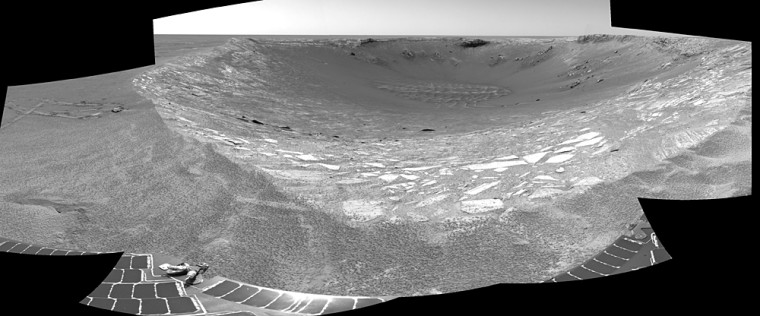The six-wheeled Opportunity Mars Exploration Rover has carefully moved its way over the rim of a large impact crater dubbed Endurance at the Meridiani Planum exploration site.
Rover operators at the Jet Propulsion Laboratory in Pasadena, Calif., have driven the vehicle forward into the crater. Opportunity's track marks and other data are being studied to guarantee that the robot has enough traction to drive deeper over the sloping terrain of the crater. The rover has executed several maneuvers successfully and is proceeding farther into Endurance.
The strategy for driving on the crater's inner slope is to keep wheels on rock surfaces instead of sand to avoid slippage.
Science target
Opportunity's observations from the rim at the top of the planned entry route show a slope of less than 20 degrees. Extensive testing at the Jet Propulsion Laboratory has convinced the robot's handlers that a substantial margin of safety exists for Opportunity to reverse its pathway and back up on a rocky slope of 25 degrees.
The robot's science target is a rock outcrop 16 to 23 feet (5 to 7 meters) from the crater rim. That area has been dubbed Karatepe.
Once at this spot, the rover is to examine the geology for several days, and then exit the crater. There are science targets beyond Karatepe, including the bottom of Endurance Crater itself. But rover-running to those locations would entail driving on sand. That could mean Opportunity might not be able to wheel itself out of the crater to higher ground.
Confidence-building
Rover operators first steered Opportunity far enough into the crater that all wheels would be on the slope of the crater. Then the rover was backtracked out of Endurance. That confidence-building drive proved that the rover was capable of getting back out before going very deep.

The other main objective was to acquire information on the degree and nature of any slip that would be experienced while traversing the crater wall.
This early “toe-dipping” into the crater went smoothly. Engineers at JPL report that slips and disturbance of the terrain were well below acceptable levels.
Team members are confident that the rover can continue wheeling forward, but they are keeping an eye on the variety of slopes and materials that Opportunity will encounter as it heads deeper into Endurance.
Jim Erickson, deputy project manager at JPL, told reporters at a news briefing Tuesday that rover operators expect to reach the primary science target — a band of rock inside Endurance Crater — about next Tuesday. The next Mars news briefing is scheduled at 1 p.m. ET Tuesday.
